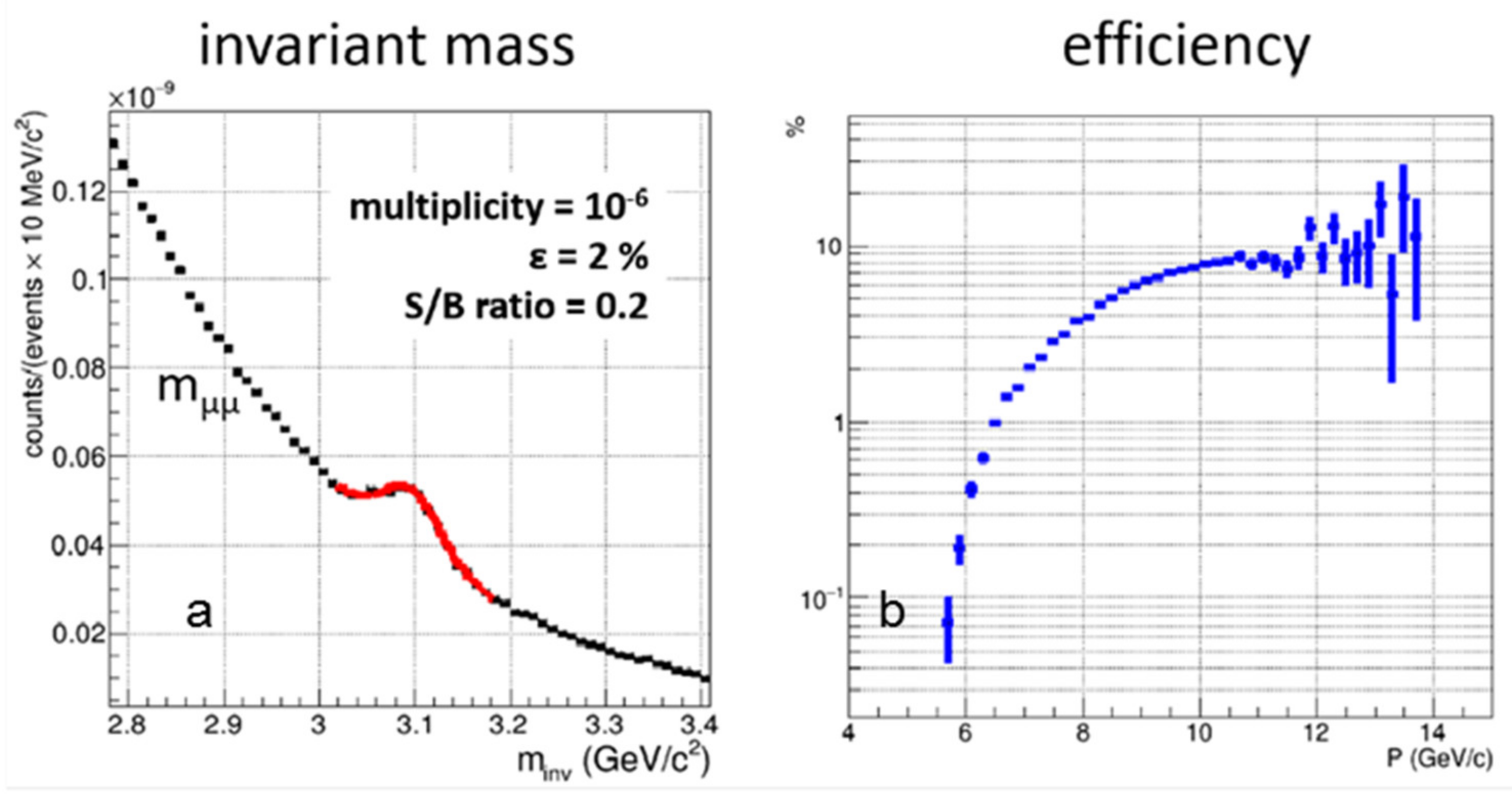Probing Compressed Baryonic Matter
Abstract
1. Introduction
2. The High-Density Equation-of-State of Nuclear Matter
3. The QCD Phase Diagram at High Baryon Densities
3.1. Fluctuations of Net-Proton Number Distribution as Signature of the Critical Endpoint
3.2. Chemical Equilibration of Multi-Strange (Anti-) Hyperons as Signature of the Onset of Deconfinement
3.3. Tracing the Caloric Curve by Detecting Dilepton Radiation
3.4. Probing Dense Nuclear Matter by Subthreshold Charmonium Production
4. The CBM Experiment at FAIR
4.1. The Facility for Antiproton and Ion Research
4.2. Layout of the CBM Experiment
4.3. Physics Performance Studies for the CBM Experiment
5. Summary
Funding
Acknowledgments
Conflicts of Interest
References
- Miller, M.C.; Lamb, F.K.; Dittmann, A.J.; Bogdanov, S.; Arzoumanian, Z.; Gendreau, K.C.; Guillot, S.; Harding, A.K. PSR J0030+0451 Mass and Radius from NICER Data and Implications for the Properties of Neutron Star Matter. Astrophys. J. Lett. 2019, 887, L24. [Google Scholar] [CrossRef]
- LIGO and Virgo Collaborations. Multi-messenger Observations of a Binary Neutron Star Merger. Astrophys. J. Lett. 2017, 848, L12. [Google Scholar] [CrossRef]
- Arsene, I.C.; Bravina, L.V.; Cassing, W.; Ivanov, Y.B.; Larionov, A.; Randrup, J.; Russkikh, V.N.; Toneev, V.D.; Zeeb, G.; Zschiesche, D. Dynamical phase trajectories for relativistic nuclear collisions. Phys. Rev. C 2007, 75, 24902. [Google Scholar] [CrossRef]
- Danielewicz, P.; Lacey, R.; Lynch, W.G. Determination of the Equation of State of Dense Matter. Science 2002, 298, 1592. [Google Scholar] [CrossRef]
- Logoteta, D.; Vidana, L.; Bombaci, I. Impact of chiral hyperonic three-body forces on neutron stars. Eur. Phys. J. A 2019, 55, 207. [Google Scholar] [CrossRef]
- Acharya, S.; Adamová, D.; Adhya, P.; Adler, A.; Adolfsson, J.; Aggarwal, M.M.; Aglieri Rinella, G.; Agnello, M.; Agrawal, N.; Ahammed, Z.; et al. Study of the Λ–Λ interaction with femtoscopy correlations in pp and p–Pb collisions at the LHC. Phys. Lett. B 2019, 797, 134822. [Google Scholar] [CrossRef]
- Andronic, A.; Braun-Munzinger, P.; Stachel, J.; Stöcker, H. Production of light nuclei, hypernuclei and their antiparticles in relativistic nuclear collisions. Phys. Lett. B 2011, 697, 203–207. [Google Scholar] [CrossRef]
- Fukushima, K.; Kojo, T.; Weise, W. Hard-core deconfinement and soft-surface delocalization from nuclear to quark matter. Phys. Rev. D 2020, 102, 096017. [Google Scholar] [CrossRef]
- Orsaria, M.; Rodrigues, H.; Weber, F.; Contrera, G.A. Quark deconfinement in high-mass neutron stars. Phys. Rev. C 2014, 89, 015806. [Google Scholar] [CrossRef]
- Stone, J.R.; Stone, N.J.; Moszkowski, S.A. Incompressibility in finite nuclei and nuclear matter. Phys. Rev. C 2014, 89, 044316. [Google Scholar] [CrossRef]
- Le Fèvre, A.; Leifels, Y.; Reisdorf, W.; Aichelin, J.; Hartnack, C. Constraining the nuclear matter equation of state around twice saturation density. Nucl. Phys. A 2016, 945, 112–133. [Google Scholar] [CrossRef]
- Sturm, C.; Böttcher, I.; Dȩbowski, M.; Förster, A.; Grosse, E.; Koczoń, P.; Kohlmeyer, B.; Laue, F.; Mang, M.; Naumann, L.; et al. Evidence for a soft nuclear equation of state from kaon production in heavy ion collisions. Phys. Rev. Lett. 2001, 86, 39. [Google Scholar] [CrossRef] [PubMed]
- Fuchs, C.; Faessler, A.; Zabrodin, E.; Zheng, Y.-M. Probing the Nuclear Equation of State by K+ Production in Heavy-Ion Collisions. Phys. Rev. Lett. 2001, 86, 1974. [Google Scholar] [CrossRef] [PubMed]
- Hartnack, C.; Aichelin, J. Analysis of kaon production around the threshold. J. Phys. G 2002, 28, 1649. [Google Scholar] [CrossRef]
- Pinkenburg, C.; Ajitanand, N.N.; Alexander, J.M.; Anderson, M.; Best, D.; Brady, F.P.; Case, T.; Caskey, W.; Cebra, D.; Chance, J.L. Elliptic Flow: Transition from Out-of-Plane to In-Plane Emission in Au + Au Collisions. Phys. Rev. Lett. 1999, 83, 1295. [Google Scholar] [CrossRef]
- Li, B.-A. Nuclear Symmetry Energy Extracted from Laboratory Experiments. Nucl. Phys. News 2017, 27, 7. [Google Scholar] [CrossRef]
- Russotto, P.; Gannon, S.; Kupny, S.; Lasko, P.; Acosta, L.; Adamczyk, M.; Al-Ajlan, A.; Al-Garawi, M.; Al-Homaidhi, S.; Amorini, F. Results of the ASY-EOS experiment at GSI: The symmetry energy at supra-saturation density. Phys. Rev. C 2016, 94, 034608. [Google Scholar] [CrossRef]
- Fuchs, C. The Nuclear Equation of State at High Densities. In Collective Motion and Phase Transitions in Nuclear Systems; World Scientific Publishing Company: Singapore, 2006. [Google Scholar]
- Fonseca, E.; Cromartie, H.T.; Pennucci, T.T.; Ray, P.S.; Kirichenko, A.Y.; Ransom, M.; Demorest, P.D.; Stairs, H. Refined Mass and Geometric Measurements of the High-Mass PSR J0740+6620. arXiv 2021, arXiv:2104.00880. [Google Scholar] [CrossRef]
- Aichelin, J.; Bratkovskaya, E.; Fevre, A.L.; Kireyeu, V.; Kolesnikov, V.; Leifels, Y.; Voronyuk, V. Parton-Hadron-Quantum-Molecular Dynamics (PHQMD)—A Novel Microscopic N-Body Transport Approach for Heavy-Ion Collisions, Dynamical Cluster Formation and Hypernuclei Production. Phys. Rev. C 2020, 101, 044905. [Google Scholar] [CrossRef]
- Estee, J.; Lynch, W.G.; Tsang, C.Y.; Barney, J.; Jhang, G.; Tsang, M.B.; Wang, R.; Kaneko, M.; Lee, J.W.; Isobe, T.; et al. Probing the Symmetry Energy with the Spectral Pion Ratio. Phys. Rev. Lett. 2021, 126, 162701. [Google Scholar] [CrossRef]
- Li, Q.; Li, Z.; Zhao, E.; Gupta, R.K. Σ−/Σ+ ratio as a candidate for probing the density dependence of the symmetry potential at high nuclear densities. Phys. Rev. C 2005, 71, 054907. [Google Scholar] [CrossRef]
- Agakishiev, G.; Arnold, O.; Balanda, A.; Belver, D.; Belyaev, A.; Berger-Chen, J.C.; Blanco, A.; Böhmer, M.; Boyard, J.L.; Cabanelas, P.; et al. Statistical model analysis of hadron yields in proton-nucleus and heavy-ion collisions at SIS 18 energies. arXiv 2015, arXiv:1512.07070. [Google Scholar]
- Cleymans, J.; Oeschler, H.; Redlich, K.; Wheaton, S. Comparison of chemical freeze-out criteria in heavy-ion collisions. Phys. Rev. C 2006, 73, 034905. [Google Scholar] [CrossRef]
- Andronic, A.; Braun-Munzinger, P.; Redlich, K.; Stachel, J. Decoding the phase structure of QCD via particle production at high energy. Nature 2018, 561, 321–330. [Google Scholar] [CrossRef] [PubMed]
- Aoki, Y.; Endrődi, G.; Fodor, Z.; Katz, S.D.; Szabó, K.K. The order of the quantum chromodynamics transition predicted by the standard model of particle physics. Nature 2006, 443, 675–678. [Google Scholar] [CrossRef] [PubMed]
- Bazavov, A.; Bhattacharya, T.; Cheng, M.; De Tar, C.; Ding, H.-T.; Gottlieb, S.; Gupta, R.; Hegde, P.; Heller, U.M.; Karsch, F.; et al. The chiral and deconfinement aspects of the QCD transition. Phys. Rev. D 2012, 85, 054503. [Google Scholar] [CrossRef]
- Ding, H.T.; Hegde, P.; Kaczmarek, O.; Karsch, F.; Lahiri, A.; Li, S.T.; Mukherjee, S.; Ohno, H.; Petreczky, P.; Schmidt, C.; et al. (HotQCD Collaboration). Chiral Phase Transition Temperature in (2 + 1)-Flavor QCD. Phys. Rev. Lett. 2019, 123, 062002. [Google Scholar] [CrossRef] [PubMed]
- Gao, F.; Pawlowski, J.M. QCD phase structure from functional methods. Phys. Rev. D 2020, 102, 034027. [Google Scholar] [CrossRef]
- Stephanov, M.A.; Rajagopal, K.; Shuryak, E.V. Event-by-event fluctuations in heavy ion collisions and the QCD critical point. Phys. Rev. D 1990, 60, 114028. [Google Scholar] [CrossRef]
- Adam, J.; Adamczyk, L.; Adams, J.R.; Adkins, J.K.; Agakishiev, G.; Aggarwal, M.M.; Ahammed, Z.; Alekseev, I.; STAR Collaboration. Net-proton number fluctuations and the Quantum Chromodynamics critical point. Phys. Rev. Lett. 2021, 126, 092301. [Google Scholar] [CrossRef] [PubMed]
- Shuryak, E.; Torres-Rincon, J.M. Light-nuclei production and search for the QCD critical point. Eur. Phys. J. A 2020, 56, 241. [Google Scholar] [CrossRef]
- Braun-Munzinger, P.; Stachel, J.; Wetterich, C. Chemical Freeze-out and the QCD Phase Transition Temperature. Phys. Lett. B 2004, 596, 6. [Google Scholar] [CrossRef]
- Andronic, A.; Braun-Munzinger, P.; Stachel, J. Thermal hadron production in relativistic nuclear collisions. Acta Phys. Pol. B 2009, 40, 1005. [Google Scholar]
- Agakishiev, G.; Balanda, A.; Bannier, B.; Bassini, R.; Belver, D.; Belyaev, A.; Blanco, A.; Böhmer, M.; Boyard, J.L.; Cabanelas, P.; et al. (HADES Collaboration) Hyperon production in Ar + KCl collisions at 1.76A GeV. Eur. Phys. J. A 2001, 47, 21. [Google Scholar] [CrossRef]
- Rapp, R.; van Hees, H. Thermal Dileptons as Fireball Thermometer and Chronometer. Phys. Lett. B 2016, 753, 586. [Google Scholar] [CrossRef]
- Specht, H.J. Thermal Dileptons from Hot and Dense Strongly Interacting Matter. AIP Conf. Proc. 2010, 1322, 1–10. [Google Scholar] [CrossRef]
- Adamczewski-Musch, J.; Arnold, O.; Behnke, C.; Belounnas, A.; Belyaev, A.; Berger-Chen, J.C.; Biernat, J.; Blanco, A.; Blume, C.; Böhmer, M.; et al. Probing baryon-rich matter with virtual photons, The HADES Collaboration. Nat. Phys. 2019, 15, 1040–1045. [Google Scholar] [CrossRef]
- Matsui, T.; Satz, H. J/ψ suppression by quark-gluon plasma formation. Phys. Lett. B 1986, 178, 416. [Google Scholar] [CrossRef]
- Gavin, S.; Vogt, R. Charmonium Suppression by Comover Scattering in Pb + Pb Collisions. Z. Phys. C 1994, 61, 351. [Google Scholar] [CrossRef]
- Abreu, M.C.; Alessandro, B.; Alexa, C.; Arnaldi, R.; Atayan, M.; Baglin, C.; Baldit, A.; Bedjidian, M.; Beolè, S.; Boldea, V.; et al. NA50 Collaboration Evidence for deconfinement of quarks and gluons from the J/ψ suppression pattern measured in Pb–Pb collisions at the CERN-SPS. Phys. Lett. B 2000, 477, 28–36. [Google Scholar] [CrossRef]
- Braun-Munzinger, P.; Stachel, J. (Non)Thermal Aspects of Charmonium Production and a New Look at J./ψ Suppression. Phys. Lett. B 2000, 490, 196–202. [Google Scholar] [CrossRef]
- Andronic, A.; Braun-Munzinger, P.; Redlich, K.; Stachel, J. Charmonium and open charm production in nuclear collisions at SPS/FAIR energies and the possible influence of a hot hadronic medium. Phys. Lett. B 2008, 659, 149. [Google Scholar] [CrossRef]
- Adam, J.; Adamová, D.; Aggarwal, M.M.; Aglieri Rinella, G.; Agnello, M.; Agrawal, N.; Ahammed, Z.; Ahmad, S.; Ahn, S.U.; Aiola, S.; et al. ALICE Collaboration. J/ψ suppression at forward rapidity in Pb–Pb collisions at √sNN = 5.02 TeV. Phys. Lett. B 2017, 766, 212. [Google Scholar] [CrossRef]
- Linnyk, O.; Bratkovskaya, E.L.; Cassing, W.; Stöcker, H. Charmonium dynamics in heavy ion collisions. Nucl. Phys. A 2007, 786, 183. [Google Scholar] [CrossRef][Green Version]
- Steinheimer, J.; Botvina, A.; Bleicher, M. Sub-threshold charm production in nuclear collisions. Phys. Rev. C 2017, 95, 014911. [Google Scholar] [CrossRef]
- FAIR—Facility for Antiproton and Ion Research in Europe. Available online: https://fair-center.de (accessed on 14 July 2021).
- Durante, M.; Indelicato, P.; Jonson, B.; Koch, V.; Langanke, K.; Meißner, U.G.; Nappi, E.; Nilsson, T.; Stöhlker, T.; Widmann, E.; et al. All the Fun of the FAIR: Fundamental physics at the Facility for Antiproton and Ion Research. Phys. Scr. 2019, 94, 033001. [Google Scholar] [CrossRef]
- GSI Helmholtzzentrum für Schwerionenforschung. Photo: D. Fehrenz, GSI/FAIR. Available online: https://www.gsi.de/en/researchaccelerators/fair/fair_civil_construction/photos_and_videos (accessed on 14 July 2021).
- Vassiliev, I.; Kisel, I. Multi-Strange Hyperon Reconstruction with the CBM Light Setup; GSI Helmholtzzentrum für Schwerionenforschung GmbH: Darmstadt, Germany, 2019; ISBN 978-3-9815227-8-5. [Google Scholar]
- Vassiliev, I.; Kisel, I.; Zyzak, M. Hypernuclei Reconstruction at the CBM Experiment; GSI Helmholtzzentrum für Schwerionenforschung GmbH: Darmstadt, Germany, 2016; ISBN 978-3-9815227-4-7. [Google Scholar]
- Feier-Riesen, C.; Lebedev, S.; Höhne, C. Investigation on Impact of Higher Material Budget in STS on LMVM; GSI Helmholtzzentrum für Schwerionenforschung GmbH: Darmstadt, Germany, 2021; ISBN 978-3-9815227-9-2. [Google Scholar]
- Senger, A.; (Facility for Antiproton and Ion Research, Darmstadt, Germany). Private communication, 2021.
- Senger, A.; Senger, P. Probing dense QCD matter: Muon measurements with the CBM experiment at FAIR. Particles 2021, 4, 19. [Google Scholar] [CrossRef]

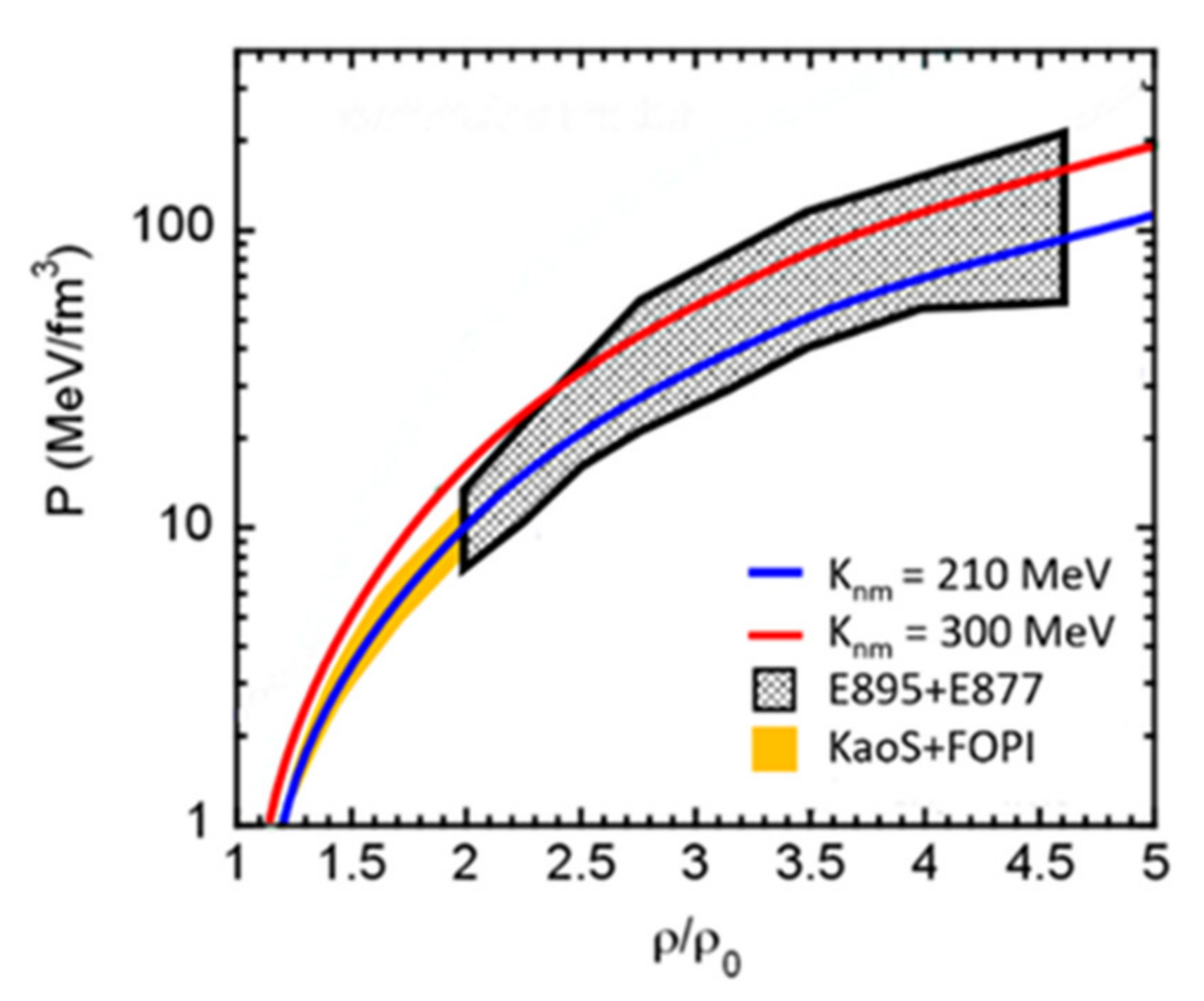
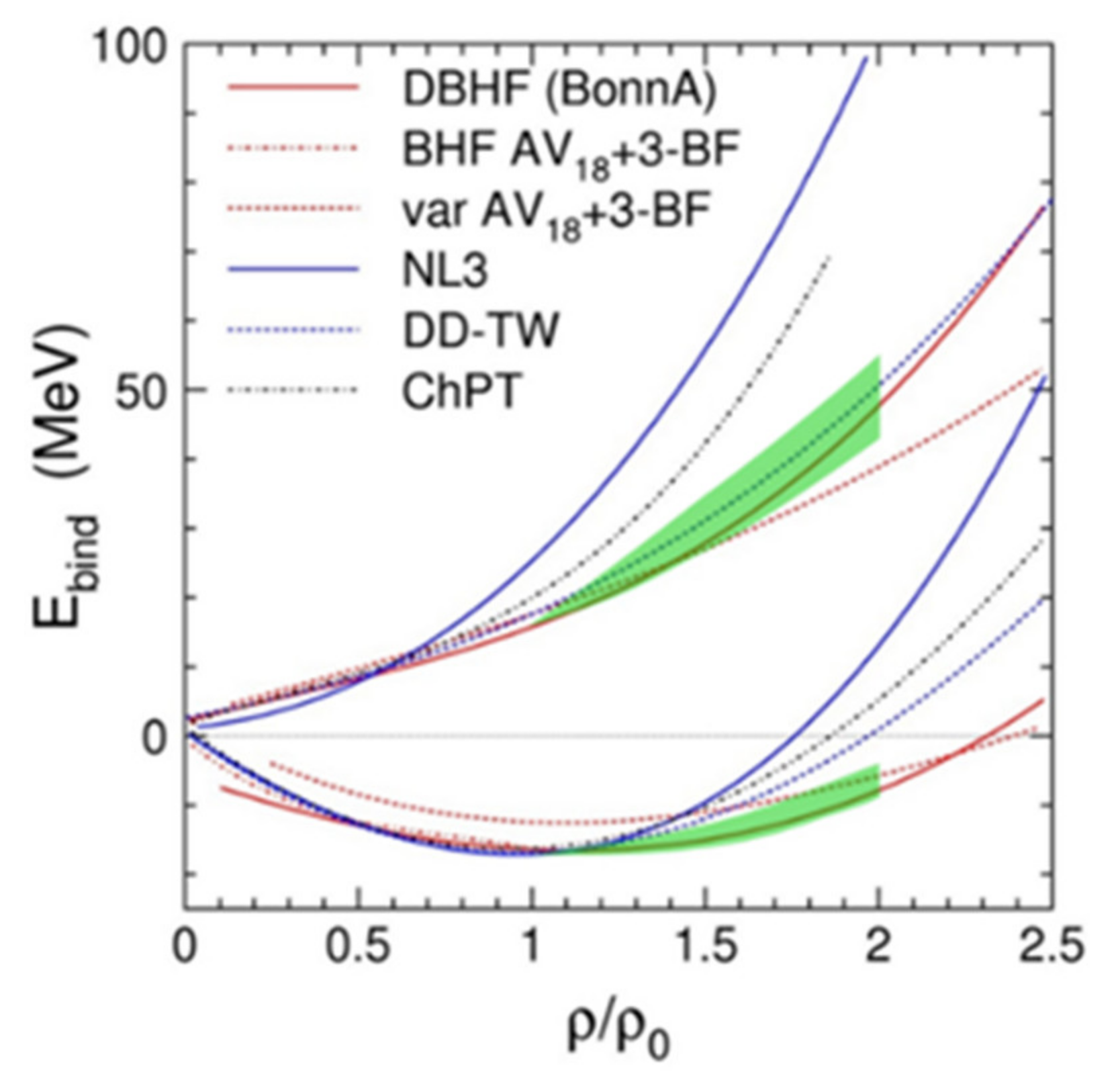
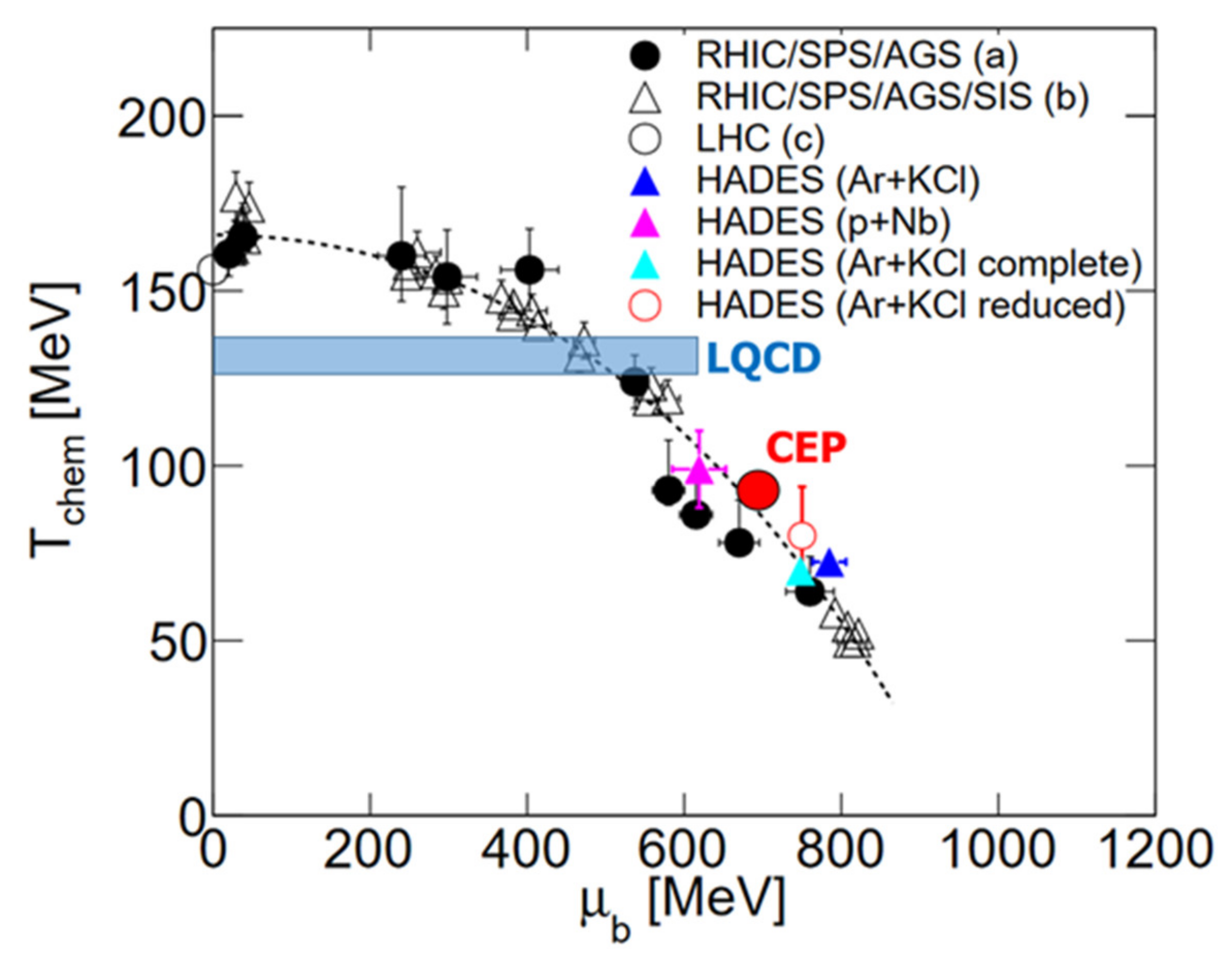
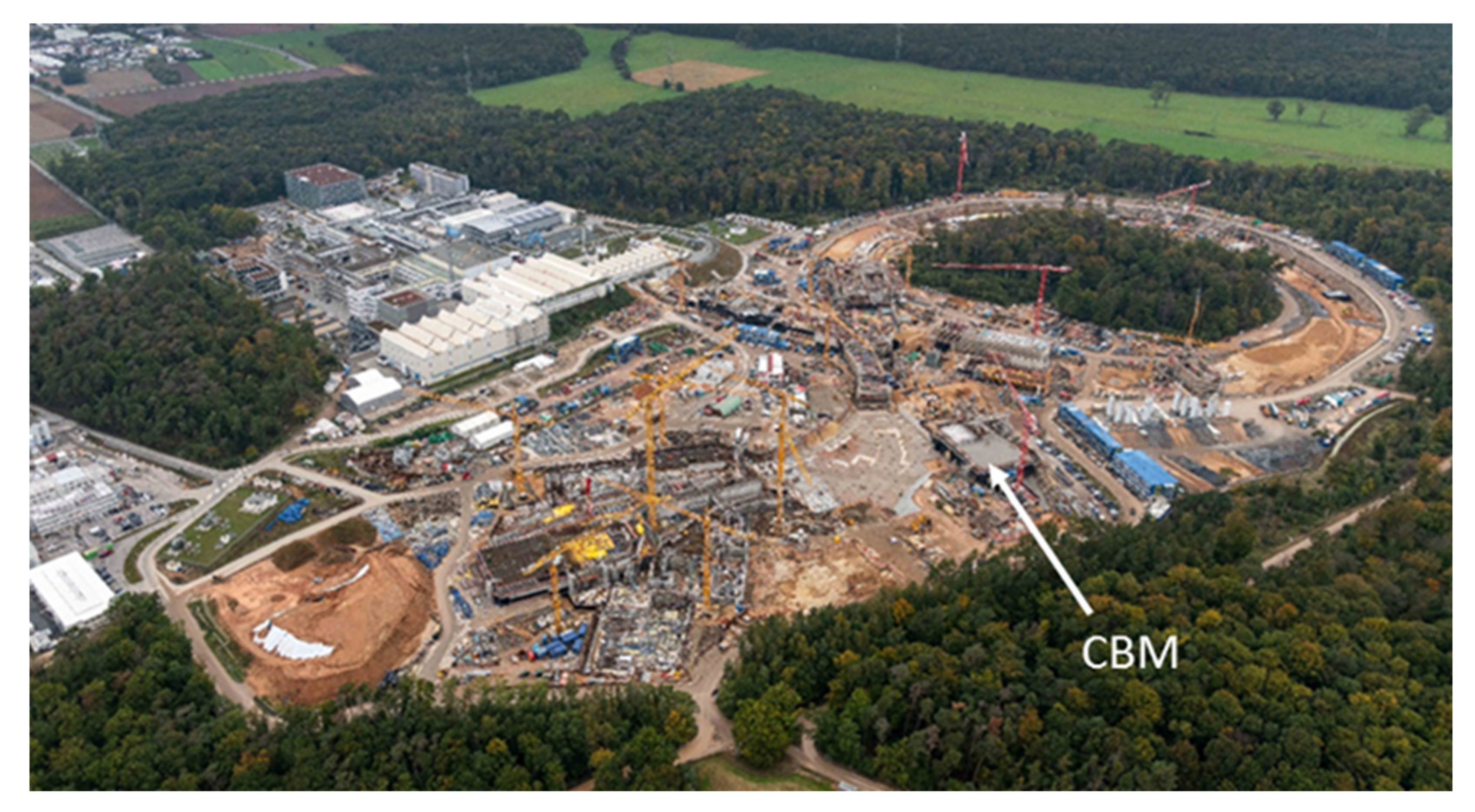

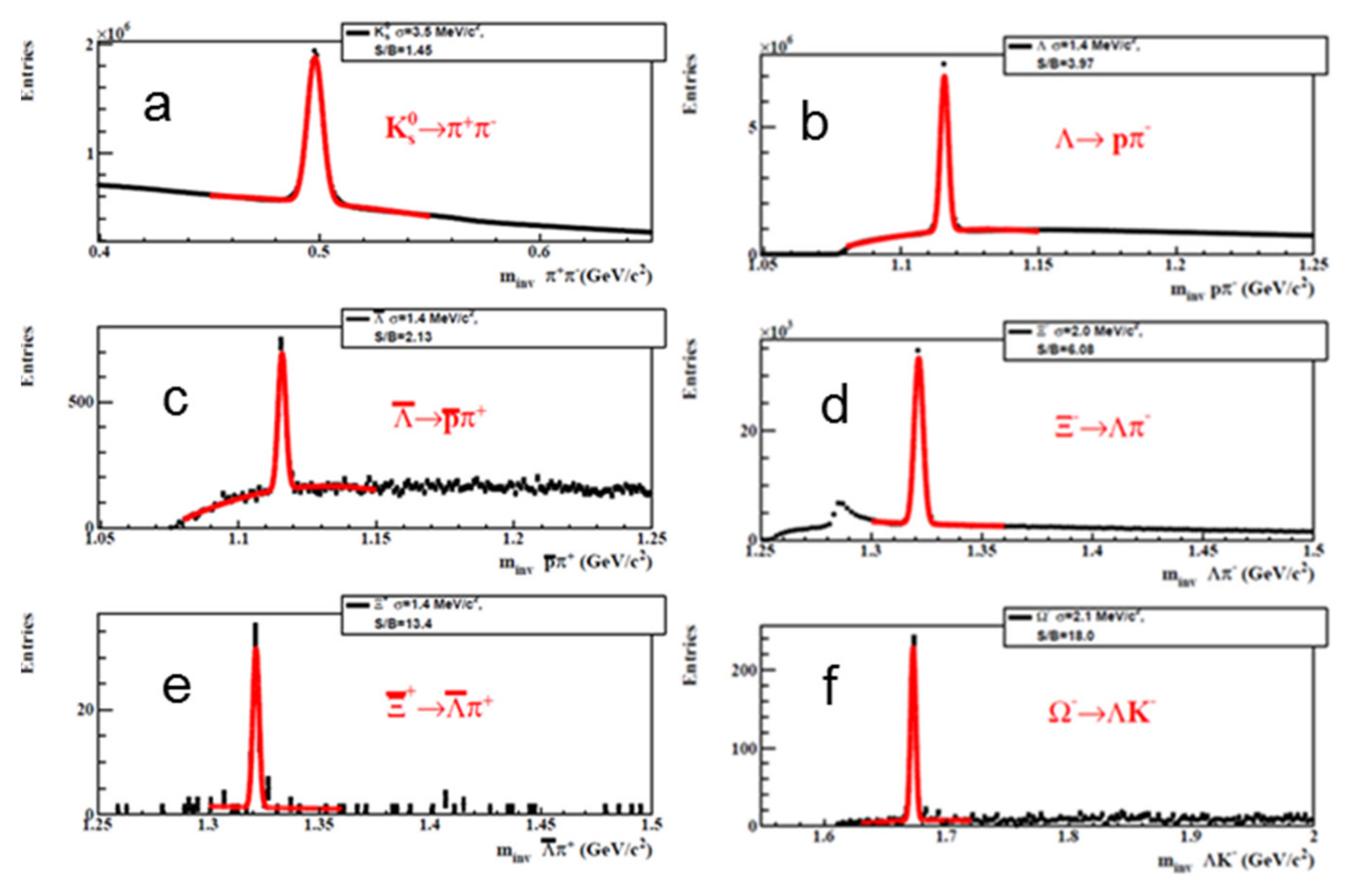
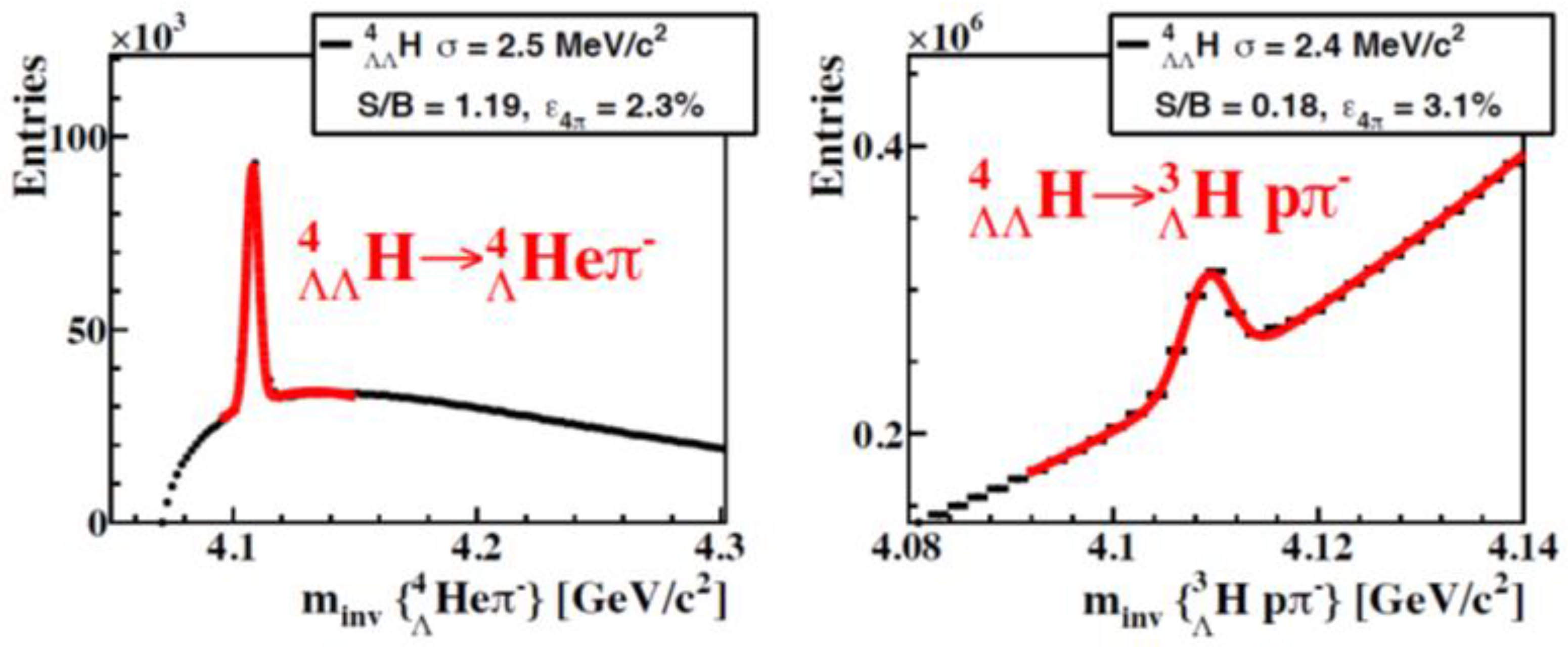
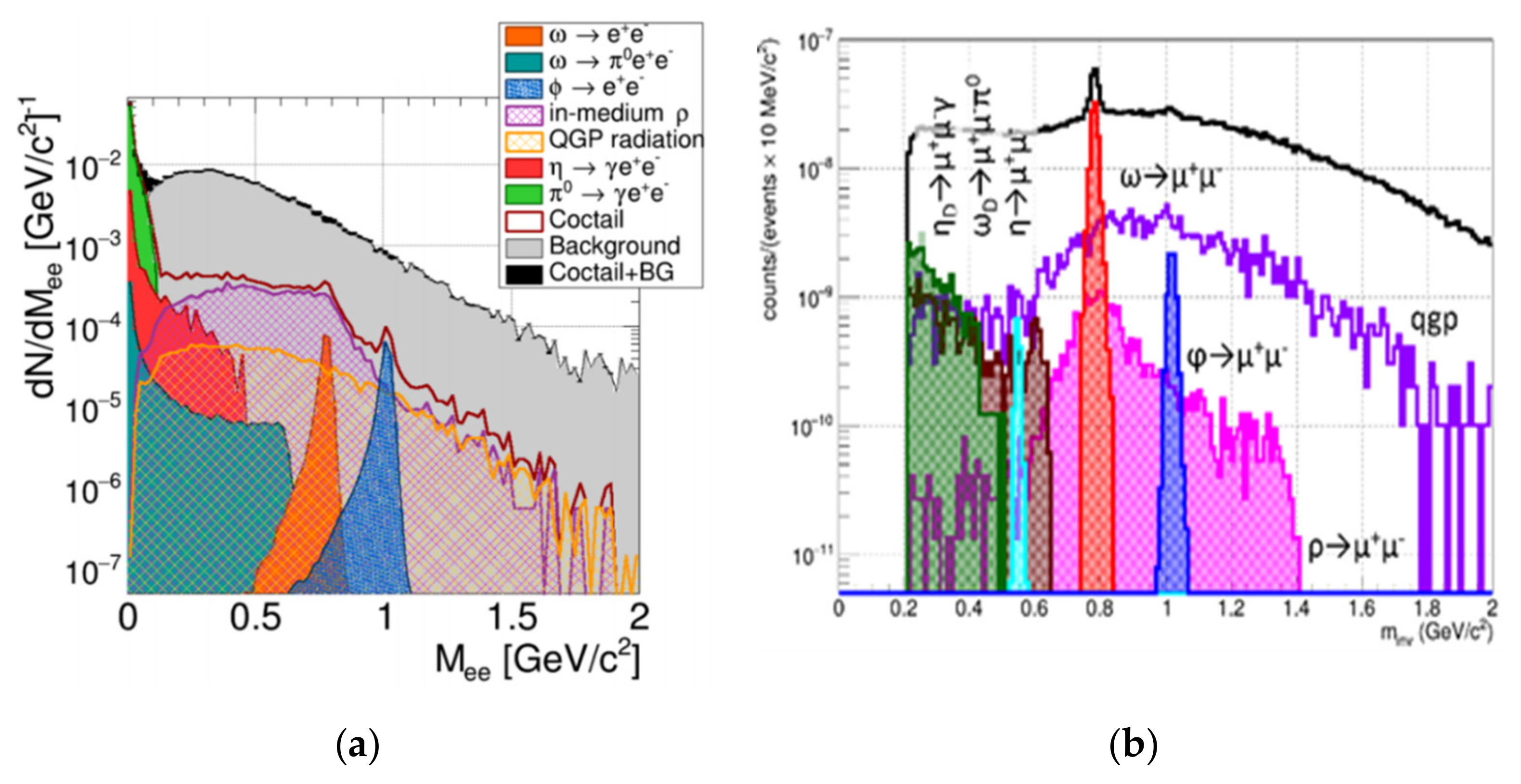
Publisher’s Note: MDPI stays neutral with regard to jurisdictional claims in published maps and institutional affiliations. |
© 2022 by the author. Licensee MDPI, Basel, Switzerland. This article is an open access article distributed under the terms and conditions of the Creative Commons Attribution (CC BY) license (https://creativecommons.org/licenses/by/4.0/).
Share and Cite
Senger, P. Probing Compressed Baryonic Matter. Universe 2022, 8, 61. https://doi.org/10.3390/universe8020061
Senger P. Probing Compressed Baryonic Matter. Universe. 2022; 8(2):61. https://doi.org/10.3390/universe8020061
Chicago/Turabian StyleSenger, Peter. 2022. "Probing Compressed Baryonic Matter" Universe 8, no. 2: 61. https://doi.org/10.3390/universe8020061
APA StyleSenger, P. (2022). Probing Compressed Baryonic Matter. Universe, 8(2), 61. https://doi.org/10.3390/universe8020061




